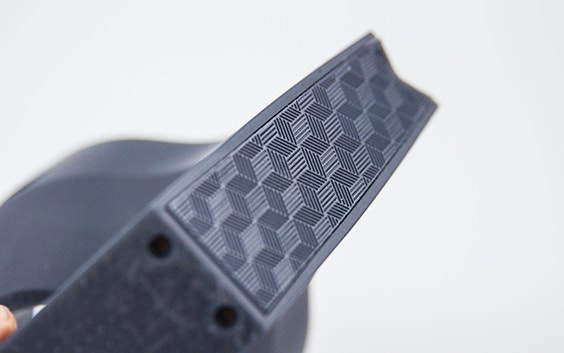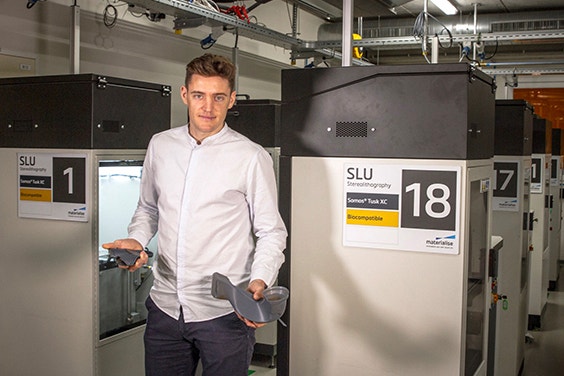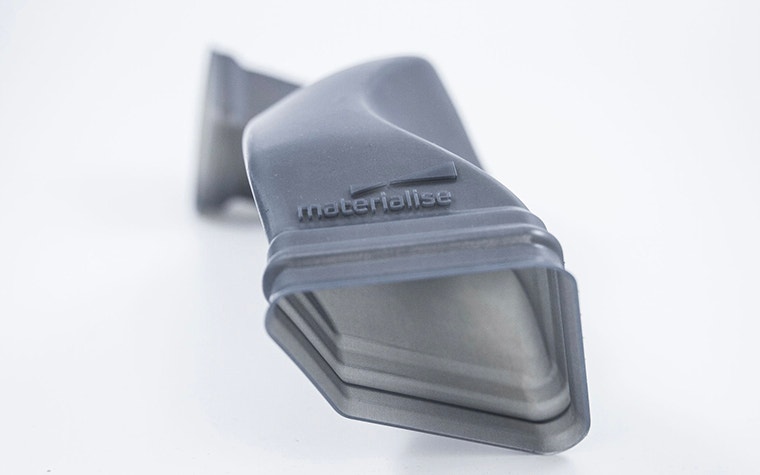EXPERT INSIGHT
4 Reasons to Make Taurus Your Automotive Prototyping Material

Materialise Process Engineer Jonas Van Eyck is used to testing new materials for 3D printing, so he understands well the advantages that different stereolithography materials offer. In this article, Jonas explains why Taurus is a great fit for the automotive industry, and gives tips on getting the most out of the material.
When Jonas first started trying out Taurus, he was well accustomed to the other stereolithography materials that we already use extensively at Materialise to produce rapid prototypes: Xtreme, PerFORM, TuskXC2700T, and more.
In Taurus, Jonas sees four big factors that make it a great fit for the automotive industry in particular, to produce prototypes for housings, flow testing and small functional parts. Here’s why you should make Taurus your new automotive prototyping material, and Jonas’ engineering insights on how best to do it.
1. Great surface quality means great first impressions
Straight out of the machine, Taurus parts are a charcoal black color with a strikingly smooth, glossy surface. “When I saw our first test builds in Taurus come off the platform, I was really impressed. It just doesn’t look like your average stereolithography material,” says Jonas.
“If you need to pitch a concept with a prototype in your hands, you start off on a much stronger footing when you know your prototype looks good. First impressions are everything, even at the prototype stage.”


Unlike white, porous parts, which are quick to attract dirt and difficult to clean, Taurus’s low porosity and dark color makes it a good choice for automotive prototyping, especially in a production environment.
“If you need a black prototype without spending time and money on post-production painting, you just need to pick Taurus with our Basic finish.”
— Jonas Van Eyck, Process Engineer at Materialise
As for design validation, the dark color is also an advantage there, points out Jonas.
“Surface defects show up better on dark colors, so it’s easier to judge whether you’re looking at a design flaw or a print process flaw. To really get the best surface quality, make sure that the surface that needs to have the best finish is facing upwards and the part is oriented at a 45-degree angle to the build platform.”
If you need help fixing your build orientation, just use our online ordering platform, Materialise OnSite.
2. Post-production? Not necessary
For the above reasons, the automotive industry is already used to ordering 3D-printed rapid prototypes in darker colors. But unlike other materials, using Taurus for automotive prototypes means you don’t need to apply paint in post-production.
In fact, if you like the black look, Jonas recommends that you keep the post-production finishing to a minimum.
“Unfinished Taurus parts are glossy and nearly black, but sandblasting causes the surface to become matte gray. So if you need a black prototype without spending time and money on post-production painting, you just need to pick Taurus with our Basic finish.”
The Basic finish on Taurus is available via Materialise OnSite, or you can get in touch with our project management team.
3. High elongation at break means it’s better for prototyping snap-fit mechanisms
Combined with the dimensional accuracy of our stereolithography machines, Taurus is perfect for not just visual prototypes but also for your form-and-fit tests. In our Taurus bull sample, in the video below, you’ll notice the flexibility of the horns.
An elongation at break that high is uncommon in stereolithography materials.
“To take full advantage of this property in Taurus, try a slightly lower wall thickness in the zones where you need to achieve flexibility,” advises Jonas. “But don’t push it below the minimum recommended, or you’ll risk warpage.”
For automotive parts, Taurus’s high elongation at break (combined with stereolithography lead times) means the opportunity to start form-and-fit tests early in your design stage. Try Taurus to prototype snap-fit mechanisms, where you need to combine flexibility and strength, or gap-and-flush inspections.


4. Low porosity, perfect for flow testing prototypes
Like all stereolithography materials, Taurus is water-resistant and non-porous. That makes it a great choice for prototypes that are needed for flow analysis and testing.
“Powder-based 3D printing plastics are great when it comes to functionality, but they always need sealing before you can use them for applications like flow testing,” says Jonas. “With stereolithography materials, you can skip that post-production sealing step and head straight into flow testing.”
以下で共有する:
